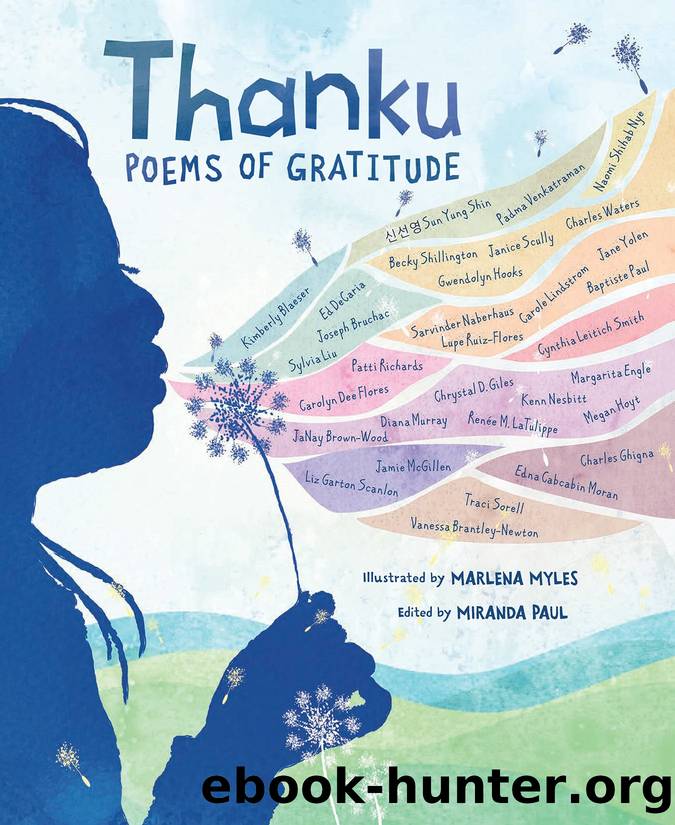Thanku by Miranda Paul

Author:Miranda Paul
Language: eng
Format: epub
Publisher: Lerner Publications Company
A tricube includes three stanzas, each with three lines,
and each line has 3 syllables. Can you count three beats in
every line of âEach Scarâ by Baptiste Paul?
A chant simply includes repeating lines or phrases and
may be one of poetryâs oldest forms. Cynthia Leitich
Smithâs poem âStories for Dinnerâ uses a repeating chant,
while the rest is written in prose (ordinary language) and
free verse (nonstructured) couplets.
A narrative poem tells a story and often is written in
the voice of the main character. Patti Richardsâs poem
âAlice Thanks the Looking Glass(es)â also makes allusions
(quick mentions or references) to a well-known story and
its characters. Donât fall asleep, or you might miss them!
In an acrostic, the first (or last) letters of a line spell out
a word or phrase. Sometimes, like in Chrystal D. Gilesâs
poem âDimples,â the title is the same as what the letters
spell.
The décima mirror is a traditional Cuban poetry form
consisting of two redondillas (8-syllable quatrains) with
a couplet (two-line) bridge, in the following rhyme
pattern: abba aa abba. Can you feel the beats bounce
during the playful walk of âIâm Thankful for My Puppyâ
by Margarita Engle?
American poet Bruce Newling invented the McWhirtle,
which, according to Kenn Nesbitt, âis basically a double-
dactyl without the requirements for a 6-syllable word or
a higgledy-piggledy nonsense phrase.â In other words,
itâs a difficult form made simpleâlike the complex ideas
of responsibility and karma easily explained within the
scenario of returning someoneâs wallet.
An ode is a poem that praises or celebrates someone or
something. Historically, many odes were meant to be
sung. Can you hear a rhythm in JaNay Brown-Woodâs
poem âFalling Leavesâ?
A mask (also called persona) is a poem written from the
point of view of an object or animal. Sometimes mask
poems feel like riddles because the speakerâs identity isnât
stated. If you covered up the title âDiary of a Sweatshirt:
The Best Day Everâ in Diana Murrayâs poem, what clues
would help someone guess who or what is speaking?
Most sonnets have fourteen lines, with 10 syllables per
line and a set pattern of rhyme. Megan Hoytâs poem
âThanksgiving at the Lakeâ follows the Shakespearean
style of sonnet, where the last couplet (two lines) reveals
an idea or conclusion.
A ballad is a poem or song that tells a story with short
lines. Many ballads, like Jamie McGillenâs âThe Perfect
Rock,â have simple rhymes and a repeating rhythm that
can be danced to or clapped out.
A pantoum is not an easy poem to write! This Malay
verse form, which became popular in Britain and France
in the 1800s, has a set pattern of how to repeat specific
lines. In Renée M. LaTulippeâs poem âAutumn by the
Sea,â the repeating lines mirror the movement of waves
that continue to lap against the shore. Can you hear the
pattern?
A limerick is a single verse with three long lines and two
short lines, in the rhyme scheme of aabba. Said to be
inspired by the Irish town of Limerick, these poems often
make people smile or laugh. What made you smile while
reading âThankful for Thinkingâ by Vanessa Brantley-
Newton?
An unrhymed cinquain (also known as a quintet) is a
five-line poem, such as Traci Sorellâs âCollege Degree.â
A palindrome is a word, phrase, verse, sentence, or even
poem that reads the same forward or backward.
Download
This site does not store any files on its server. We only index and link to content provided by other sites. Please contact the content providers to delete copyright contents if any and email us, we'll remove relevant links or contents immediately.
| Around the World | Chinese New Year |
| Christmas | Easter |
| Halloween | Independence Day |
| Jewish | Kwanzaa |
| Non-religious | Religious |
| St. Patrick's Day | Thanksgiving |
| Valentine's Day |
The Landing of the Pilgrims by James Daugherty(2894)
Frankly, Frannie by AJ Stern(2169)
Molly's Surprise by Valerie Tripp(1817)
Pumpkinheads by Rainbow Rowell(1632)
Letters From Father Christmas by J. R. R. Tolkien(1532)
Finley (Sunset Cove #1) by Ella Frank(1441)
Doll Bones by Holly Black(1422)
The Christmas Genie by Dan Gutman & Dan Santat(1311)
Richard Scarry's Christmas Mice (Little Golden Book) by Richard Scarry(1285)
Just Juliet by Charlotte Reagan(1277)
Captain Nobody by Dean Pitchford(1273)
How the Grinch Stole Christmas (Classic Seuss) by Dr. Seuss(1249)
The Berenstain Bears and the Spooky Old Tree by Stan Berenstain(1224)
The Box of Delights by Masefield John(1177)
The Nutcracker by E. T. A. Hoffmann(1161)
Hurry! Hurry! by Eve Bunting(1159)
Ollie's Halloween by Olivier Dunrea(1155)
100 Cupboards 01: 100 Cupboards by N. D. Wilson(1155)
Secret Santa by Sabrina James(1051)
